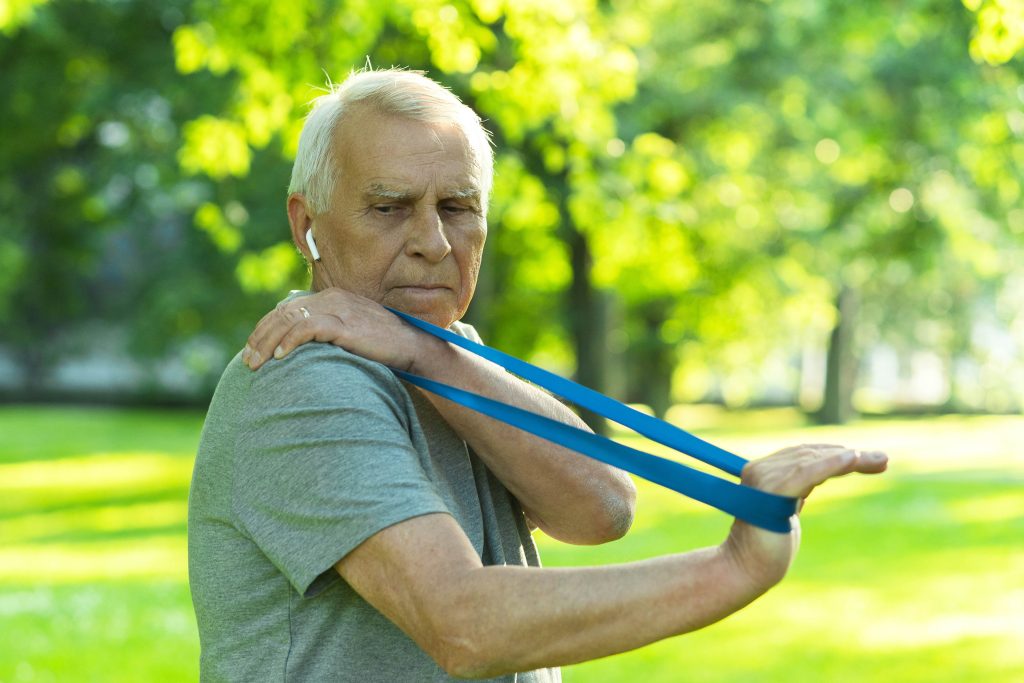
Research indicates that over 70% of seniors aged 60 and above don’t exercise at all. Yet the American Heart Association, as well as the American College of Sports Medicine, recommend that adults 65 years and older do a minimum of 150 minutes of physical activity each week. These should include resistance exercises at least twice a week.
Resistance band exercises involve the use of an elastic band that forces your muscles to work against the band’s tension. Resistance band exercises help in improving balance, flexibility, muscle strength, coordination, and range of motion. They are also great for fighting the loss of bone common in the elderly as well as combating the symptoms associated with arthritis.
In this article, we look at some of the best resistance band exercises recommended for seniors.

Why Resistance Bands?
Before diving in, it’s important to touch upon why resistance bands are ideal workout tools for people over 50.
Resistance bands are the most popular alternative to dumbbells. The advantages of resistance bands over dumbbells become even more significant when you factor in the aging body. Resistance bands are more forgiving in terms of workout technique, so the possibility of strain or injury is greatly reduced. Overall, many find resistance bands are easier on their joints, and this benefit is partically appreciated by elders. It creates a comfortable workout experience and those inevitable aches and pains become less of a barrier to consistent exercise.
Seated Row
Aging increases one’s risk of developing back problems including back pain. By strengthening your back muscles, you reduce this risk as well as help manage the pain.
To perform the seated row exercise, sit on the floor and extend your legs right in front of you as you dig the heels into the ground. Hold one handle of the resistance band with each hand, looping it over the soles of the feet. Sitting up, pull your shoulder blades together and down. Straightening your arms to your front, raise them just a few inches above the legs. Lastly, pull the band handles into your chest but don’t allow the handles to touch your body as you do so. Slowly spread out your elbows while keeping the band in place. Repeat the series several times depending on your ability.
Bicep Curls
These are great for improving the upper body strength in seniors. It helps them manage to do tasks such as lifting and carrying items without straining. They are particularly important for strengthening the arms.
To perform a bicep curl, simply hold the resistant band’s handles, one in each hand and then stand in the middle of your band. Bend your knees a little while relaxing your arms to the side with palms fronting forward. While straightening the back and tightening the stomach muscles, lift the handles towards the shoulders without making contact. As you lower the hands, keep the band in control. Repeat the set as desired.
Upright Row
The American Academy of Orthopedic Surgeons suggests that osteoarthritis in the shoulder affects most individuals over the age of 50. The Upright row is an exercise that helps strengthen the tendons, muscles, and ligaments surrounding your shoulder joints. This ultimately helps in improving the range of motion and minimizing pain caused by osteoarthritis.
This is how you do the upright row. First, hold each handle of your resistance band in each hand before resting your hands at the top of the legs. Next, stand on the band right in the middle as you straighten your back. Slowly move the handles towards the chest. As you pull upward, ensure the elbows are bent and allow them to sort of flare at the sides. When the handles reach right next to your chest, slowly bring down your hands to the original position. Repeat as desired.

Conclusion
Resistance bands are ideal for eliminating strain and making exercise easy on the joints. Thus, it should be no surprise that resistance bands are the go-to equipment for many seniors.
The sheer variety of exercises you can do with bands is tremendous. The ones described here provide a solid foundation to build upon.
—
Photo: Diabetes Care







